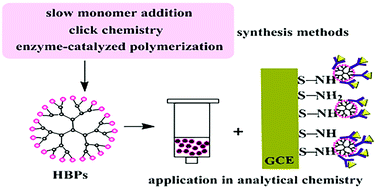Synthesis of hyperbranched polymers and their applications in analytical chemistry
Abstract
Hyperbranched polymers (HBPs) have attracted increasing attention of scientists due to their unique physical and chemical properties, as well as their potential applications in different fields. Many methods for the preparation of HBPs have hitherto been reported. This review focuses primarily on several novel synthesis methods for various HBPs. We present and discuss the advantages and disadvantages as well as recent advances relating to such synthesis methods, namely the slow monomer addition method, click chemistry, and the enzyme-catalyzed polymerization method. Besides, the applications of HBPs in analytical chemistry fields such as sample pretreatment and immunosensors have also been briefly summarized.


 Please wait while we load your content...
Please wait while we load your content...